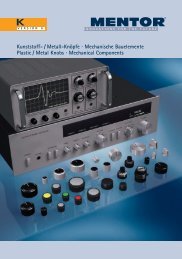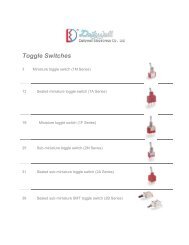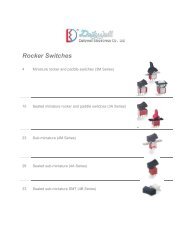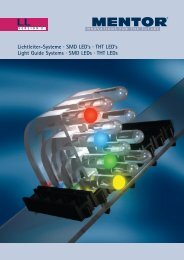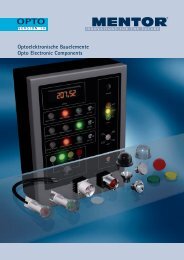Isolation Transmitters
Isolation Transmitters
Isolation Transmitters
You also want an ePaper? Increase the reach of your titles
YUMPU automatically turns print PDFs into web optimized ePapers that Google loves.
Vin-<br />
<strong>Isolation</strong> Amplifier Module<br />
<strong>Isolation</strong> Amplifier Module<br />
<strong>Isolation</strong> Amplifier<br />
Module<br />
Passive Loop Power Supply<br />
<strong>Isolation</strong> Amplifier<br />
T1100L-F <strong>Isolation</strong> transmitter is a kind of two-wire loop powered isolation<br />
module.A isolation power is transmitted from the 4 ~20mA current loop to<br />
power the former two-wire transmitter and receive the 4~20mA current<br />
signal from the two-wire transmitter.Adopting unique electromagnetism<br />
isolation design and high efficiency loop electric-larceny technology<br />
independent power supply is not required for the module, realizing<br />
4~20mA standard signal isolation with high accuracy it match to kinds of<br />
equipment module input attachment (PLC/DCS act); Overcurrent<br />
Protection is designed to protect the isolation module and the latter circuit;<br />
Besides, the module have extremely low temperature drift(no more than<br />
35PPM/ ℃ under -25 ℃ ~+71 ℃ ).The isolation voltage between the input<br />
and output can be up to 3KVDC.<br />
T1100L-F PACKAGE INFORMATION AND PIN ASSIGNMENT<br />
1.50<br />
(0.059)<br />
14.50<br />
(0.571)<br />
0.50<br />
(0.020)<br />
1 2 9 101112<br />
ELECTRICAL CHARACTERISTICS<br />
Input<br />
Parameter<br />
Output<br />
Parameter<br />
32.00(1.260)<br />
(SIP12 Package)<br />
Note:First angle projection<br />
Two-wire<br />
System Transmitter<br />
4~20mA<br />
7.90<br />
(0.311)<br />
4.1(0.161)<br />
2.54(0.100)<br />
1 2 9101112<br />
Input Signal...........4~20mA<br />
Overload ..............≤30mA(Over-current protection)<br />
Voltage Drop-out...Typ: 5V(@ input = 20mA)<br />
Output Signal..........4~20mA<br />
2.54(0.100)<br />
1.00(0.039)<br />
Load Capacity.........RL≤(Us–5)/0.02<br />
PRODUCT USING CONNECTION<br />
PRODUCT PROGRAM<br />
+<br />
+<br />
-<br />
-<br />
12<br />
11 Input<br />
10<br />
9<br />
Output<br />
300VDC Electrical <strong>Isolation</strong><br />
PIN<br />
1( Iin+ )<br />
2( Io)<br />
9,10(Iin)<br />
11,12(Vout)<br />
Us:loop power supply voltage<br />
1<br />
2<br />
(10~<br />
30VDC)<br />
+<br />
4~20mA<br />
+<br />
- -<br />
DCS or PLC<br />
+ -<br />
10~30VDC<br />
RL<br />
FUNCTION<br />
Power input<br />
current output<br />
current input<br />
Power output<br />
Unit:mm(inch)<br />
Pin tolerances:±0.10mm(± 0.004inch)<br />
General tolerances:±0.5mm(±0.020inch)<br />
T11 0 0 L-F<br />
FEATURES<br />
Loop power supply Over-current Protection<br />
<strong>Isolation</strong> voltage(3KVDC/60s)<br />
Extremely low temperature drift(35ppm/℃)<br />
Industry standard(Operating temperature:<br />
-25℃ ~ 71℃)<br />
High reliability(MTBF>500,000 hours)<br />
TRANSMISSION CHARACTERISTICS<br />
Zero Offset.................... 0.4%F.S.<br />
Gain Error...................... 0.4%F.S.<br />
Temperature Drift............0.0035%F.S./℃(-25℃~+71℃)<br />
Loop power supply<br />
Package style<br />
<strong>Isolation</strong> power output<br />
Power supply<br />
Signal output<br />
Signal input<br />
<strong>Isolation</strong> amplifier<br />
ISOLATION CHARACTERISTICS<br />
Galvanic lsolation...............Two-port isolation(Between input and output)<br />
<strong>Isolation</strong> Voltage.............3KVDC (Tested for 1minute,leakage current<br />
500,000 hours)<br />
Temperature Drift.........0.0035%F.S./℃ (-25℃ ~ +71℃)<br />
ISOLATION CHARACTERISTICS<br />
Galvanic <strong>Isolation</strong>.......Four-port isolation (Between input, output,<br />
power supply and isolation power output)<br />
<strong>Isolation</strong> Voltage..........2.5KVDC (Tested for 1minute and leakage current



